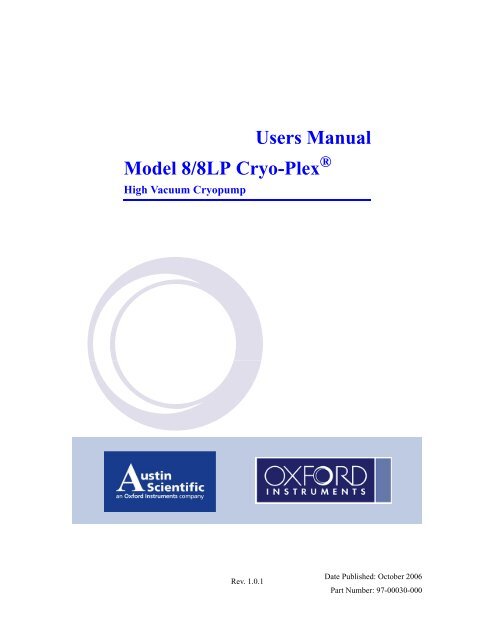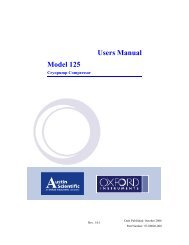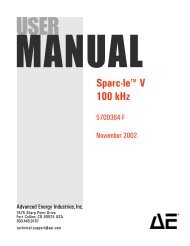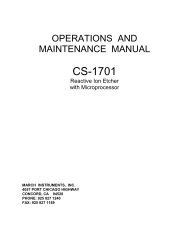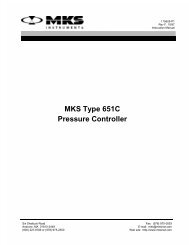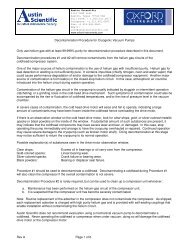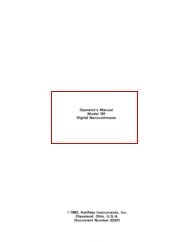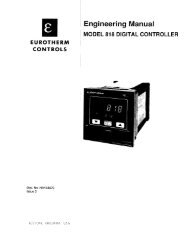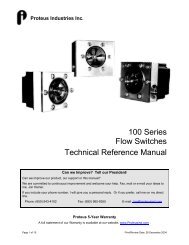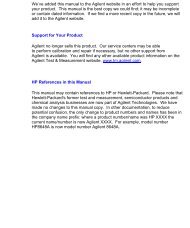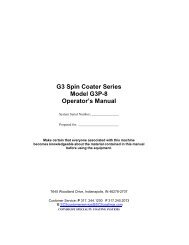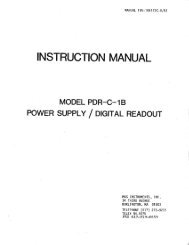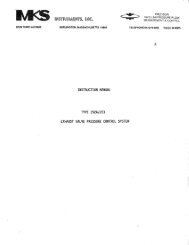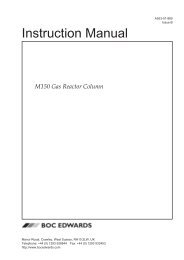Users Manual Model 8/8LP Cryo-Plex - REMRSEC Facilities
Users Manual Model 8/8LP Cryo-Plex - REMRSEC Facilities
Users Manual Model 8/8LP Cryo-Plex - REMRSEC Facilities
You also want an ePaper? Increase the reach of your titles
YUMPU automatically turns print PDFs into web optimized ePapers that Google loves.
<strong>Users</strong> <strong>Manual</strong><br />
<strong>Model</strong> 8/<strong>8LP</strong> <strong>Cryo</strong>-<strong>Plex</strong> ®<br />
High Vacuum <strong>Cryo</strong>pump<br />
Rev. 1.0.1<br />
Date Published: October 2006<br />
Part Number: 97-00030-000
Austin Scientific is a wholly-owned subsidiary of Oxford Instruments. For information about<br />
Oxford Instruments, visit the Oxford Instruments Web site at:<br />
http://www.oxford-instruments.com/<br />
How to Contact Austin Scientific Support:<br />
For contact information and a complete listing of Direct Sales, Distributor, and Sales<br />
Representative contacts, visit the Austin Scientific Web site at:<br />
http://www.austinscientific.com/<br />
Austin Scientific has made its best effort to ensure that the information contained in this document is<br />
accurate and reliable. However, the information is subject to change without notice and is provided “AS<br />
IS” without warranty of any kind (express or implied). Before placing orders, customers are advised to<br />
obtain the latest version of relevant information to verify that information being relied upon is current and<br />
complete. All products are sold subject to the terms and conditions of sale supplied at the time of order<br />
acknowledgment, including those pertaining to warranty, patent infringement, and limitation of liability. No<br />
responsibility is assumed by Austin Scientific for the use of this information, including use of this<br />
information as the basis for manufacture or sale of any items, nor for infringements of patents or other<br />
rights of third parties.<br />
This document is the property of Austin Scientific and by furnishing this information, Austin Scientific<br />
grants no license, express or implied, under any patents, copyrights, trademarks, trade secrets, or other<br />
intellectual property rights of Austin Scientific. Austin Scientific, copyright owner of the information<br />
contained herein, gives consent for copies to be made of the information only for use within the<br />
customer’s organization as related to the use of Austin Scientific products. The same consent is given for<br />
similar information contained on any Austin Scientific Web site or disk used to distribute information to a<br />
customer. Austin Scientific does give consent to the copying or reproduction by any means of the<br />
information contained herein for general distribution, advertising or promotional purposes, or for creating<br />
any work for resale. The names of products of Austin Scientific or other vendors and suppliers appearing<br />
in this document may be trademarks or service marks of their respective owners that may be registered<br />
in some jurisdictions. A list of Austin Scientific trademarks and service marks can be found at: http://<br />
www.austinscientific.com/.<br />
Austin Scientific<br />
An Oxford Instruments Company<br />
4114 Todd Lane<br />
Austin, Texas 78744 USA<br />
TEL. +1 512 441 6893<br />
FAX +1 512 443 6665<br />
Email: Info@austinscientific.com<br />
Copyright (©) 2006 by Oxford Instruments, All rights reserved.<br />
<strong>Model</strong> 8/<strong>8LP</strong> <strong>Cryo</strong>-<strong>Plex</strong> ® <strong>Cryo</strong>pump <strong>Users</strong> <strong>Manual</strong><br />
ii
Contents<br />
Contents<br />
1 Preface ......................................................................................................................................1-1<br />
1.1 About Austin Scientific...................................................................................................1-1<br />
1.2 Other Services from Austin Scientific ............................................................................1-1<br />
1.3 About this <strong>Manual</strong>..........................................................................................................1-1<br />
1.4 Compatibility ..................................................................................................................1-2<br />
2 Safety Warnings and Operator Instructions...............................................................................2-1<br />
2.1 Safety Warnings ............................................................................................................2-1<br />
2.1.1 Standards for the Use of Warnings and Cautions.................................................2-1<br />
2.1.2 Warnings Applicable to All Aspects of the Operation of<br />
<strong>Model</strong> 8/<strong>8LP</strong> <strong>Cryo</strong>pumps ......................................................................................2-1<br />
2.1.3 Operator Instructions ............................................................................................2-1<br />
3 Introduction................................................................................................................................3-1<br />
3.1 General Information about the <strong>Model</strong> 8/<strong>8LP</strong> <strong>Cryo</strong>pump ................................................3-1<br />
3.1.1 <strong>Model</strong> 8/<strong>8LP</strong> <strong>Cryo</strong>pump Features.........................................................................3-1<br />
3.2 Specifications ................................................................................................................3-2<br />
3.3 Ordering Information......................................................................................................3-6<br />
3.4.1 Standard Equipment and Accessories..................................................................3-6<br />
3.4.2 Optional Accessories and Replacement Parts......................................................3-6<br />
4 Installation..................................................................................................................................4-1<br />
4.1 Safety Warnings ............................................................................................................4-1<br />
4.2 Inspect Equipment before Installing ..............................................................................4-1<br />
4.3 Tools Needed for Installation.........................................................................................4-1<br />
4.4 Installing the <strong>Model</strong> 8/<strong>8LP</strong> <strong>Cryo</strong>pump............................................................................4-1<br />
4.5 Installing a Roughing Pump...........................................................................................4-2<br />
5 Operations and Controls............................................................................................................5-1<br />
5.1 <strong>Model</strong> 8/<strong>8LP</strong> <strong>Cryo</strong>pump Functional Operations.............................................................5-1<br />
5.1.1 <strong>Cryo</strong>pump Preparation..........................................................................................5-1<br />
5.1.2 Normal Operation .................................................................................................5-1<br />
5.1.2.1<strong>Cryo</strong>pump Start-up ..................................................................................5-1<br />
5.1.2.2Rough Pumping .......................................................................................5-2<br />
5.1.2.3Regeneration of the <strong>Cryo</strong>pump................................................................5-2<br />
5.1.2.3.1 Unassisted Regeneration ......................................................................5-2<br />
5.1.2.3.2 Assisted Regeneration...........................................................................5-2<br />
5.1.2.3.3 Automatic Regeneration ........................................................................5-2<br />
6 Troubleshooting.........................................................................................................................6-1<br />
6.1 Troubleshooting Activities..............................................................................................6-1<br />
7 Maintenance ..............................................................................................................................7-1<br />
7.1 Maintenance Personnel Requirements .........................................................................7-1<br />
7.2 Tools Needed to Service the <strong>Model</strong> 8/<strong>8LP</strong> <strong>Cryo</strong>pump ..................................................7-1<br />
7.3 Scheduled Preventative Maintenance ...........................................................................7-1<br />
7.3.1 Preparation Before Decontamination....................................................................7-1<br />
<strong>Model</strong> 8/<strong>8LP</strong> <strong>Cryo</strong>-<strong>Plex</strong> ® <strong>Cryo</strong>pump <strong>Users</strong> <strong>Manual</strong><br />
iii
Contents<br />
7.3.2 Purging the Regulator and Charging Line ............................................................7-1<br />
7.3.3 Pressurize and Vent the Cold Head .....................................................................7-2<br />
7.3.4 Reconnect Gas Lines to Complete Decontamination ...........................................7-2<br />
7.4 Cleaning Equipment ......................................................................................................7-2<br />
7.5 Returning Equipment.....................................................................................................7-2<br />
Figures<br />
3-1 <strong>Model</strong> 8 <strong>Cryo</strong>pumps ................................................................................................................ 3-3<br />
3-2 <strong>Model</strong> 8 <strong>Cryo</strong>pump Dimensions .............................................................................................. 3-4<br />
3-3 <strong>Model</strong> <strong>8LP</strong> <strong>Cryo</strong>pump Dimensions ......................................................................................... 3-5<br />
4-1 Connection Diagram ............................................................................................................... 4-2<br />
Tables<br />
3-1 CP8 Physical Characteristics.....................................................................................................3-2<br />
3-2 CP<strong>8LP</strong> Physical Characteristics ................................................................................................3-2<br />
3-3 <strong>Model</strong> 8/<strong>8LP</strong> <strong>Cryo</strong>pump Ordering Information ...........................................................................3-6<br />
3-4 Optional Accessories and Replacement Parts ..........................................................................3-6<br />
Revision History<br />
Date Revision Description<br />
August 2006 1.0.1 Conversion to new format.<br />
<strong>Model</strong> 8/<strong>8LP</strong> <strong>Cryo</strong>-<strong>Plex</strong> ® <strong>Cryo</strong>pump <strong>Users</strong> <strong>Manual</strong><br />
iv
Preface 1<br />
1.1 About Austin Scientific<br />
Austin Scientific, a wholly-owned subsidiary of Oxford Instruments, specializes in the<br />
manufacture and repair of cryogenic vacuum pumps, cryocoolers (refrigerators) and helium<br />
compressors for semiconductor, optical coating, linear accelerators, medical equipment, and R&D<br />
applications.<br />
You can find just what you need from our range of products and support services.<br />
• New Equipment - cryopumps, such as the <strong>Model</strong> 8/<strong>8LP</strong> cryopumps described in this manual,<br />
compressors, cryocoolers, and cryopump controllers.<br />
• Comprehensive range of accessories for the installation of whole systems and a complete<br />
range of spare parts to repair cryopumps and compressors.<br />
1.2 Other Services from Austin Scientific<br />
Austin Scientific offers a broad range of additional services:<br />
• Repair and refurbishment services - Whatever brand of cryo-components you have, we offer<br />
fully warranted refurbishment, often with off-the-shelf availability.<br />
• Exchanges - We offer our own quality products, as well as most makes of cryopumps and<br />
helium compressors, which are refurbished and fully warranted.<br />
• Technical Support - Our support engineers will help determine if your cryopump system is<br />
operating correctly so that you can get your system back to optimum efficiency as soon as<br />
possible.<br />
To contact Austin Scientific Technical Support:<br />
Email: support@austinscientific.com<br />
• Telephone: 1-512-441-9258 or Toll Free: 1-800-404-1055<br />
• Installation - On-site installation services are available to guarantee performance and save you<br />
time.<br />
• Training - We offer on-site training to help you and your staff to know more about your<br />
cryopump and compressor systems. Our training will give you confidence and the ability to<br />
maintain a highest possible uptime for your system.<br />
1.3 About this <strong>Manual</strong><br />
The purpose of this manual is to provide our customers using the <strong>Model</strong> 8/<strong>8LP</strong> <strong>Cryo</strong>pumps with<br />
information needed to safely and efficiently operate the cryopump when operating as part of a<br />
cryogenic refrigeration system. Such a system is often comprised of the following equipment:<br />
• <strong>Cryo</strong>pump compressor unit such as the <strong>Model</strong> 125 compressor from Austin Scientific<br />
<strong>Model</strong> 8/<strong>8LP</strong> <strong>Cryo</strong>-<strong>Plex</strong> ® <strong>Cryo</strong>pump <strong>Users</strong> <strong>Manual</strong><br />
1-1
<strong>Model</strong> 8/<strong>8LP</strong> <strong>Cryo</strong>-<strong>Plex</strong> ® <strong>Cryo</strong>pump—Preface<br />
• Coldhead/cryopump<br />
• Connecting Helium lines.<br />
This manual describes the design, operation and maintenance of a CP8/<strong>8LP</strong> cryopump unit.<br />
1.4 Compatibility<br />
The <strong>Model</strong> 8/<strong>8LP</strong> cryopumps are designed for use with Austin Scientific <strong>Model</strong> 125 helium<br />
cryopump compressor (or equivalent).<br />
<strong>Model</strong> 8/<strong>8LP</strong> <strong>Cryo</strong>-<strong>Plex</strong> ® <strong>Cryo</strong>pump <strong>Users</strong> <strong>Manual</strong><br />
1-2
Safety Warnings 2<br />
2.1 Safety Warnings<br />
2.1.1 Standards for the Use of Warnings and Cautions<br />
Warnings are noted when there is a possibility of injury or death to persons operating the<br />
equipment or performing specific tasks or procedures noted in this manual.<br />
Cautions are noted when there is a possibility of damage to equipment if the caution is ignored.<br />
2.1.2 Warnings Applicable to All Aspects of the Operation of <strong>Model</strong> 8/<strong>8LP</strong> <strong>Cryo</strong>pumps<br />
Warning<br />
Warning<br />
Warning<br />
Warning<br />
Warning<br />
Warning<br />
If the <strong>Model</strong> 8/<strong>8LP</strong> cryopump has been used to pump any toxic or dangerous<br />
materials, this information and associated paperwork must be listed on all shipping<br />
containers and on associated paperwork before the equipment is returned to<br />
Austin Scientific for any repairs.<br />
When pumping any toxic, corrosive, or flammable gases, a vent pipe must be<br />
connected to the cryopump relief valve and vented to a safe location.<br />
Do not install a hot filament vacuum gauge on the cryopump side of the Hi-Vac gate<br />
valve as this could be a source of ignition.<br />
Helium gas can cause rapid asphyxiation and death if released in a confined area.<br />
Use a pressure reducing regulator when with-drawing Helium gases from a high<br />
pressure cylinder<br />
Detaching the helium flex lines with the compressor load at low temperature can<br />
cause the pressure rise in the system beyond the permissible level therefore<br />
creating a safety hazard.<br />
2.1.3 Operator Instructions<br />
Follow standard CP8/CP<strong>8LP</strong> operating procedures as described in this manual. If after reading this<br />
manual, you still have questions regarding the safe operation of the CP8/CP<strong>8LP</strong> cryopump, please<br />
contact Austin Scientific Technical Support using the contact information found in Chapter 1,<br />
Section 1.2.<br />
<strong>Model</strong> 8/<strong>8LP</strong> <strong>Cryo</strong>-<strong>Plex</strong> ® <strong>Cryo</strong>pump <strong>Users</strong> <strong>Manual</strong><br />
2-1
Introduction 3<br />
3.1 General Information about the <strong>Model</strong> 8/<strong>8LP</strong> <strong>Cryo</strong>pump<br />
Austin Scientific provides both custom and industry standard cryogenic solutions at highly<br />
competitive prices. <strong>Cryo</strong>genic vacuum pumps provide clean, oil-free high vacuum with high<br />
pumping speeds are the pump of choice for sputtering, electron beam evaporation, accelerator<br />
beam lines and many aerospace and coating applications.<br />
<strong>Model</strong> 8/<strong>8LP</strong> cryopumps are available in various standard inlet flange configurations - ANSI, ISO,<br />
CF and complete UHV, with temperature sensors either in diode or hydrogen-vapor-bulb (HVB)<br />
configurations.<br />
3.1.1 <strong>Model</strong> 8/<strong>8LP</strong> <strong>Cryo</strong>pump Features<br />
The <strong>Model</strong> 8/<strong>8LP</strong> cryopumps, as seen in Figure 3-1, are typically used in the following<br />
applications:<br />
• Sputtering tools<br />
• Ion implanters<br />
• R & D bell-jar systems<br />
• Surface analysis<br />
• Accelerators<br />
• Beam lines<br />
• General vacuum systems<br />
<strong>Model</strong> 8/<strong>8LP</strong> <strong>Cryo</strong>-<strong>Plex</strong> ® <strong>Cryo</strong>pump <strong>Users</strong> <strong>Manual</strong><br />
3-1
<strong>Model</strong> 8/<strong>8LP</strong> <strong>Cryo</strong>-<strong>Plex</strong> ® <strong>Cryo</strong>pump—Introduction<br />
3.2 Specifications<br />
This section describes the specifications for the <strong>Model</strong> 8/<strong>8LP</strong> cryopumps.<br />
Table 3-1.<br />
CP8 Physical Characteristics<br />
Characteristic<br />
Height<br />
Maximum Flange Diameter<br />
Weight<br />
Measurement<br />
20.5 Inches<br />
11.0 Inches<br />
45 lbs<br />
Table 3-2.<br />
CP<strong>8LP</strong> Physical Characteristics<br />
Characteristic<br />
Length (ANSI)<br />
Length (CF)<br />
Length (ISO)<br />
Depth<br />
Weight<br />
Measurement<br />
22.6 Inches<br />
22.1 Inches<br />
21.8 Inches<br />
7.1 Inches<br />
42 lbs<br />
• Pumping Speeds (liter/sec.)<br />
— Air: 1500<br />
— Water: 4000<br />
— Hydrogen:<br />
•2500 (CP8)<br />
•2200 (CP<strong>8LP</strong>)<br />
— Argon: 1200<br />
• Argon Throughput<br />
— 700 scc/min.<br />
• Capacity:<br />
— Argon: 1000 standard liters<br />
— Hydrogen: 20 standard liters @ 5x10e-6 torr<br />
• Crossover: 150 torr-liters<br />
• Cool Down Time (Room temperature to 20K): 90 minutes<br />
• Inlet Flange (Size: Standard)<br />
— 6-inch: ANSI<br />
—10-inch: CF<br />
— NW 200: ISO<br />
Note:<br />
<strong>Model</strong> 8/<strong>8LP</strong> cryopumps can operate safely in any mounting orientation.<br />
<strong>Model</strong> 8/<strong>8LP</strong> <strong>Cryo</strong>-<strong>Plex</strong> ® <strong>Cryo</strong>pump <strong>Users</strong> <strong>Manual</strong><br />
3-2
<strong>Model</strong> 8/<strong>8LP</strong> <strong>Cryo</strong>-<strong>Plex</strong> ® <strong>Cryo</strong>pump—Introduction<br />
Figure 3-1.<br />
<strong>Model</strong> 8 <strong>Cryo</strong>pump<br />
<strong>Model</strong> 8/<strong>8LP</strong> <strong>Cryo</strong>-<strong>Plex</strong> ® <strong>Cryo</strong>pump <strong>Users</strong> <strong>Manual</strong><br />
3-3
<strong>Model</strong> 8/<strong>8LP</strong> <strong>Cryo</strong>-<strong>Plex</strong> ® <strong>Cryo</strong>pump—Introduction<br />
Figure 3-2.<br />
<strong>Model</strong> 8 <strong>Cryo</strong>pump Dimensions (Larger Print at the End of This <strong>Manual</strong>)<br />
10" CONFLAT FLANGE<br />
.33 THRU HOLES<br />
x 24, EQ SP<br />
ON A 9.13 B.C.<br />
10" CF Gasket<br />
3.87<br />
Austin Scientific Co.<br />
CP-8 Conflat Inlet<br />
20.92<br />
14.14<br />
8.00<br />
PRESSURE RELIEF VALVE<br />
14.64<br />
DIODE/HVB TEMP.<br />
SENSOR CONNECTION<br />
1.44<br />
1.94<br />
6.86<br />
COLDHEAD MOTOR<br />
ELECTRICAL CONNECTION<br />
3.44 3.09<br />
2.50<br />
KF-25 FLANGE<br />
(W/BLANK,O-RING,<br />
& CLAMP)<br />
REGEN PURGE PORT<br />
<strong>Model</strong> 8/<strong>8LP</strong> <strong>Cryo</strong>-<strong>Plex</strong> ® <strong>Cryo</strong>pump <strong>Users</strong> <strong>Manual</strong><br />
3-4
<strong>Model</strong> 8/<strong>8LP</strong> <strong>Cryo</strong>-<strong>Plex</strong> ® <strong>Cryo</strong>pump—Introduction<br />
Figure 3-3.<br />
<strong>Model</strong> <strong>8LP</strong> <strong>Cryo</strong>pump Dimensions (Larger Print at the End of This <strong>Manual</strong>)<br />
REGEN PURGE PORT<br />
4.80<br />
8.00<br />
3.00<br />
11.00<br />
ANSI FLANGE<br />
O-RING SEAL<br />
Austin Scientific Co.<br />
CP-<strong>8LP</strong> ANSI Flange<br />
17.06<br />
10.78<br />
7.67<br />
4.98<br />
KF-25 FLANGE<br />
(W/BLANK, O-RING,<br />
& CLAMP)<br />
DIODE TEMP.<br />
SENSOR CONNECTION<br />
1.44<br />
COLDHEAD MOTOR<br />
ELECTRICAL CONNECTION<br />
2.50<br />
3.17<br />
7.02<br />
5.63<br />
PRESSURE<br />
RELIEF VALVE<br />
<strong>Model</strong> 8/<strong>8LP</strong> <strong>Cryo</strong>-<strong>Plex</strong> ® <strong>Cryo</strong>pump <strong>Users</strong> <strong>Manual</strong><br />
3-5
<strong>Model</strong> 8/<strong>8LP</strong> <strong>Cryo</strong>-<strong>Plex</strong> ® <strong>Cryo</strong>pump—Introduction<br />
3.3 Ordering Information<br />
3.3.1 Standard Equipment and Accessories<br />
Table 3-3 contains the ordering information for the <strong>Model</strong> 8/<strong>8LP</strong> cryopumps.<br />
Table 3-3.<br />
<strong>Model</strong> 8/<strong>8LP</strong> <strong>Cryo</strong>pump Ordering Information<br />
<strong>Cryo</strong>pump<br />
Part Number<br />
<strong>Cryo</strong>-<strong>Plex</strong> 8 (ANSI Flange, Diode) 10157<br />
<strong>Cryo</strong>-<strong>Plex</strong> 8 (ANSI Flange, HVB) 10164<br />
<strong>Cryo</strong>-<strong>Plex</strong> 8 (CF Inlet, Diode) 10230<br />
<strong>Cryo</strong>-<strong>Plex</strong> 8 (CF, UHV, HVB) 10190<br />
<strong>Cryo</strong>-<strong>Plex</strong> 8 (UHV, Diode) 10226<br />
<strong>Cryo</strong>-<strong>Plex</strong> 8 (ISO, Diode) 10227<br />
<strong>Cryo</strong>-<strong>Plex</strong> 8 (ISO Inlet, HVB) 10228<br />
<strong>Cryo</strong>-<strong>Plex</strong> <strong>8LP</strong> (ANSI Flange, Diode)<br />
92-00006-0AD<br />
<strong>Cryo</strong>-<strong>Plex</strong> <strong>8LP</strong> (UHV, Diode) 10219<br />
3.3.2 Optional Accessories and Replacement Parts<br />
The customer can order the optional accessories and replacement parts listed in Table 3-4.<br />
Table 3-4.<br />
Optional Accessories and Replacement Parts<br />
Accessories/Replacement Parts<br />
Part Number<br />
Blanket heater for CP8<br />
BH-8<br />
Purge gas valve 10185<br />
Purge gas valve heater 10340<br />
Rough valve 10191<br />
Burst disc<br />
BD-133<br />
Relief valve cover 60210<br />
Drive unit power cable (10 ft.) 10144-10<br />
Diode monitor 10132<br />
Diode cable for diode monitor (10 ft.) 10133-10<br />
<strong>Model</strong> 2100 Automatic <strong>Cryo</strong>pump Controller 10310<br />
CP8/<strong>8LP</strong> Installation Kit 10251<br />
<strong>Model</strong> 8/<strong>8LP</strong> <strong>Cryo</strong>-<strong>Plex</strong> ® <strong>Cryo</strong>pump <strong>Users</strong> <strong>Manual</strong><br />
3-6
Installation 4<br />
4.1 Safety Warnings<br />
Review the safety warnings found in Chapter 2 before starting any installation activities.<br />
4.2 Inspect Equipment before Installing<br />
Remove the cryopump from the box and inspect for any damage during shipping. Notify Austin<br />
Scientific immediately if any damage was found.<br />
4.3 Tools Needed for Installation<br />
The Installation Kit for the <strong>Model</strong> 8/<strong>8LP</strong> cryopump is offered as an optional accessory that can be<br />
ordered from Austin Scientific. Refer to Chapter 3, Section 3.3 for the part number.<br />
4.4 Installing the <strong>Model</strong> 8/<strong>8LP</strong> <strong>Cryo</strong>pump<br />
Follow these steps to install the <strong>Model</strong> 8/<strong>8LP</strong> cryopump.<br />
1. Clean all sealing surfaces, apply a thin film of vacuum grease to inlet flange o-ring and<br />
install it.<br />
2. Bolt cryopump to the chamber HI-Vac gate valve.<br />
3. Attach roughing valve to the KF 25 flange on the purge tube adaptor of the cryopump.<br />
4. Remove dust plugs from any Aeroquip Self Sealing Couplings and inspect gasket<br />
seals.<br />
5. Connect helium gas lines in the following order.<br />
a. Use a helium flexline to connect the “Return” ports on both the <strong>Model</strong> 8/<strong>8LP</strong> and the<br />
compressor.<br />
b. Use a helium flexline to connect the “Supply” ports on both the <strong>Model</strong> 8/<strong>8LP</strong> and the<br />
compressor.<br />
6. Check gas pressure gauge per compressor specifications.<br />
7. Connect cold-head drive cable from cryopump to compressor.<br />
8. Connect diode cable to temperature monitor if applicable.<br />
9. Connect main power cable per compressor specifications.<br />
Figure 4.1 shows a typical installation diagram when making connections.<br />
<strong>Model</strong> 8/<strong>8LP</strong> <strong>Cryo</strong>-<strong>Plex</strong> ® <strong>Cryo</strong>pump <strong>Users</strong> <strong>Manual</strong><br />
4-1
<strong>Model</strong> 8/<strong>8LP</strong> <strong>Cryo</strong>-<strong>Plex</strong> ® <strong>Cryo</strong>pump—Installation<br />
Figure 4-1.<br />
Connection Diagram<br />
4.5 Installing a Roughing Pump<br />
To install a roughing pump, follow these steps:<br />
1. Connect the roughing pump system directly to the accessory port located on the<br />
cryopump.<br />
2. A vacuum gauge and roughing valve should be installed as close as possible to the<br />
cryopump.<br />
3. Install an oil backstreaming device (foreline trap) in series to the roughing pump.<br />
<strong>Model</strong> 8/<strong>8LP</strong> <strong>Cryo</strong>-<strong>Plex</strong> ® <strong>Cryo</strong>pump <strong>Users</strong> <strong>Manual</strong><br />
4-2
Operations and Controls 5<br />
5.1 <strong>Model</strong> 8/<strong>8LP</strong> <strong>Cryo</strong>pump Operations<br />
5.1.1 <strong>Cryo</strong>pump Preparation<br />
When a cryopump has been in storage for a period of time or when receiving a new one, the<br />
charcoal array of the cryopump may be loaded with moisture or other contaminants. A so-called<br />
“Extended Nitrogen Purge” process should be performed to get the cryopump to its desired<br />
condition before cool-down operation.<br />
Follow these steps of the “Extended Nitrogen Purge” process:.<br />
1. Install the cryopump per procedures described in Chapter 4, Section 4.4, leak check all mounting seals<br />
and valves to ensure the cryopump is leak-tight.<br />
2. Make sure the cryopump is at room temperature.<br />
3. Using a gas supply flexline with proper connections to connect a nitrogen gas (N 2 ) cylinder (with a<br />
pressure regulator) to the purge gas valve of the cryopump.<br />
4. Open the purge gas valve and regulate the pressure of nitrogen gas to between 18 to 30 psi.<br />
5. Turn on the purge gas heater.<br />
6. Continue the purging process for at least 4 hours.<br />
7. Turn off the purge gas heater and close the purge gas valve.<br />
8. Clean and then remount the o-ring of the relief valve on the cryopump.<br />
The cryopump unit is now ready for start-up operation.<br />
5.1.2 Normal Operation<br />
5.1.2.1 <strong>Cryo</strong>pump Start-up<br />
1. Make sure the gate valve to the main chamber is closed.<br />
2. Open the rough valve of the cryopump and rough to appropriate crossover pressure level.<br />
3. Perform Rate of Rise test to verify proper regeneration and leak rate of the cryopump. Normally a 10<br />
micron/minute rate of rise is considered acceptable. If the Rate of Rise test fails, leak check the cryopump<br />
and the gate valve first and fix any leak that is present. If the test still fails after that, repeat the “Extended<br />
Nitrogen Purge” process described in Section 5.1.1.<br />
4. Rough pump the cryopump back to its appropriate crossover pressure level.<br />
5. Close the rough valve and start the compressor that runs the cryopump.<br />
6. When a cryopump is operating properly, it usually takes about 90~100 minutes to reach 20K.<br />
7. Once the cryopump reaches its operating cryogenic temperature, observe the pressure in the main<br />
vacuum chamber before opening the gate valve and starting cryopumping the chamber.<br />
<strong>Model</strong> 8/<strong>8LP</strong> <strong>Cryo</strong>-<strong>Plex</strong> ® <strong>Cryo</strong>pump <strong>Users</strong> <strong>Manual</strong><br />
5-1
<strong>Model</strong> 8/<strong>8LP</strong> <strong>Cryo</strong>-<strong>Plex</strong> ® <strong>Cryo</strong>pump—Operations and Controls<br />
5.1.2.2 Rough Pumping<br />
8. The crossover pressure of the main vacuum chamber from rough pump to cryopumping should be at 150<br />
torr-liters. Only open the gate valve when this condition is met.<br />
Observe the following cautions when rough pumping the cryopump:<br />
Caution:<br />
Caution:<br />
Do not begin to rough pump the cryopump without knowing the pre-determined<br />
roughing pressure.<br />
Never rough pump the cryopump longer than necessary, it could result In backstreaming<br />
of mechanical pump oil that will contaminate the cryopump.<br />
5.1.2.3 Regeneration of the <strong>Cryo</strong>pump<br />
Since cryopumps are capture type pumps, they must be periodically warmed up and evacuated in<br />
order to remove the accumulated condensed and adsorbed gases. The process of warming up and<br />
evacuating gases from a cryopump is called regeneration.<br />
5.1.2.3.1 Unassisted Regeneration<br />
1. Close the high vacuum gate valve and turn off the compressor and cryopump.<br />
2. The cryopump condensing arrays should be allowed to warm up to 80°F (26°C, 300K).<br />
3. Begin roughing the cryopump to the crossover pressure, close roughing valve and restart compressor and<br />
cryopump.<br />
4. <strong>Cryo</strong>pump is now ready for cool-down.<br />
5.1.2.3.2 Assisted Regeneration<br />
1. Close the high vacuum gate valve and turn off the compressor and cryopump.<br />
2. Using a heated dry gas (nitrogen/argon) begin to purge the cryopump through the purge gas valve. The<br />
purge gas should be injected at 1 to 2 cfm and a maximum temperature of 150°F(65°C,338K). Austin<br />
Scientific offers a purge gas valve heater option that can limited the heated purge gas temperature to<br />
150°F.<br />
3. The exterior of the cryopump may be heated using a blanket heater available from Austin<br />
Scientific Co. (P/N BH-8, BH-<strong>8LP</strong>). Never let the surface exceed 150°F(65°C).<br />
4. When the temperature sensor of the cryopump reaches 80°F (26°C, 300K), discontinue the<br />
regeneration process, rough the cryopump to the initial starting pressure, close the roughing<br />
valve and restart compressor and cryopump.<br />
5. <strong>Cryo</strong>pump is now ready for cool-down procedures.<br />
5.1.2.3.3 Automatic Regeneration<br />
Automatic regeneration of the cryopump can be accomplished by the use of the <strong>Model</strong> 2100/2200<br />
Automatic <strong>Cryo</strong>pump Controller, available from Austin Scientific. Automatic regeneration occurs<br />
when predetermined pressure or temperature set points are exceeded.<br />
<strong>Model</strong> 8/<strong>8LP</strong> <strong>Cryo</strong>-<strong>Plex</strong> ® <strong>Cryo</strong>pump <strong>Users</strong> <strong>Manual</strong><br />
5-2
Troubleshooting 6<br />
6.1 Troubleshooting Activities<br />
Table 6-1 describes some problems that users might encounter while operating the <strong>Model</strong> 8/<strong>8LP</strong><br />
<strong>Cryo</strong>pump and provides solutions to those problems.<br />
<strong>Model</strong> 8/<strong>8LP</strong> <strong>Cryo</strong>-<strong>Plex</strong> ® <strong>Cryo</strong>pump <strong>Users</strong> <strong>Manual</strong><br />
6-1
<strong>Model</strong> 8/<strong>8LP</strong> <strong>Cryo</strong>-<strong>Plex</strong> ® <strong>Cryo</strong>pump—Troubleshooting<br />
Table 6-1.<br />
Troubleshooting Procedures<br />
Problem Possible Cause Corrective Action<br />
High base pressure<br />
of vacuum system<br />
and the cryopump<br />
temperature is<br />
below 20K.<br />
High base pressure<br />
of vacuum system,<br />
and the cryopump<br />
temperature is<br />
above 20K.<br />
<strong>Cryo</strong>pump fails to<br />
cool down to the<br />
required operating<br />
temperature or<br />
takes too long to<br />
reach that<br />
temperature.<br />
<strong>Cryo</strong>pump has<br />
intermittent<br />
ratcheting or<br />
thumping sound<br />
during operation.<br />
1. Vacuum leak in vacuum<br />
system or in cryopump.<br />
2. High partial pressure of<br />
non-condensable (helium,<br />
hydrogen, or neon) within<br />
the cryopump because the<br />
charcoal array of the<br />
cryopump has reached full<br />
capacity.<br />
1. High partial pressure of<br />
non-condensable (helium,<br />
hydrogen, or neon) within<br />
the cryopump because the<br />
15K array has reached full<br />
capacity.<br />
2. Excessive thermal load.<br />
3. Decrease in cryopump<br />
cold head performance.<br />
1. Low helium supply<br />
pressure.<br />
2. Vacuum leak in vacuum<br />
system or cryopump.<br />
3. High partial pressure of<br />
non-condensable (helium,<br />
hydrogen, or neon) within<br />
the cryopump.<br />
4. Compressor problem.<br />
1. Check the following for leaks:<br />
• Check the vacuum chamber and hi-vac/<br />
gate valve for leaks<br />
• Check cryopump relief valve for proper<br />
seating<br />
• Check cryopump for leaks (after closing<br />
the gate valve)<br />
2. Regenerate the cryopump per<br />
Chapter 5, Section 5.1.2.3<br />
1. Regenerate the cryopump using the<br />
instructions in Chapter 5,<br />
Section 5.1.2.3. Recool the cryopump,<br />
making note of:<br />
• Cooldown time to the operating<br />
temperature<br />
• Time to achieve the desired operating<br />
vacuum level of the cryopump<br />
Compare these figures to those<br />
indicated in the operating log. If they<br />
are significantly different, then refer to<br />
Possible Cause 3 of this problem,<br />
“Decrease in cryopump cold head<br />
performance”.<br />
2. Reduce the thermal radiation load by:<br />
• Shielding the cryopump<br />
• Lowering the temperature of the radiating<br />
surface.<br />
3. If the helium pressure gauge reads<br />
below the normal-operating pressure,<br />
add helium gas according to procedure<br />
described in the compressor manual.<br />
Regenerate and recool the cryopump.<br />
If the temperature remains above 20K,<br />
the problem may be within the cold<br />
head and contact Austin Scientific for<br />
assistance.<br />
1. Add helium gas according to procedure<br />
described in the compressor manual.<br />
2. Check vacuum system for leaks.<br />
• Check cryopump relief valve for proper<br />
seating.<br />
• Check cryopump for leaks.<br />
3. Regenerate the cryopump as described<br />
in Chapter 5, Section 5.1.2.3<br />
4. Refer to the “Troubleshooting” section<br />
of the compressor manual.<br />
1. Helium gas contamination 1. Refer to Chapter 7, Section 7.3.1. for<br />
instructions on how to decontaminate<br />
the cryopump.<br />
<strong>Model</strong> 8/<strong>8LP</strong> <strong>Cryo</strong>-<strong>Plex</strong> ® <strong>Cryo</strong>pump <strong>Users</strong> <strong>Manual</strong><br />
6-2
Maintenance 7<br />
7.1 Maintenance Personnel Requirements<br />
Only trained and qualified personnel should perform the maintenance procedures described in this<br />
chapter. Observe safety warnings described in Chapter 2. All other maintenance work must be<br />
performed by Austin Scientific personnel in the factory. Please contact Austin Scientific to make<br />
arrangement for such work. See contact information in Chapter 1, Section 1.2.<br />
Caution:<br />
Always use two wrenches when connecting or disconnecting the Aeroquip selfsealing<br />
couplings.<br />
7.2 Tools Needed to Service the <strong>Model</strong> 8/<strong>8LP</strong> <strong>Cryo</strong>pump<br />
The following tools are needed to carry out the maintenance activities described in this chapter.<br />
Refer to Chapter 3, Section 3.3 for the correct part number:<br />
• Maintenance manifold<br />
• Two self-sealing coupling wrenches<br />
7.3 Scheduled Preventative Maintenance<br />
7.3.1 Preparation Before Decontamination<br />
1. Cool down the cryopump for at least one (1) hour.<br />
2. Shut down the compressor and cryopump. Then immediately disconnect the supply<br />
and return gas lines from the compressor.<br />
3. Connect the supply and return helium gas lines to the maintenance manifold. Use the<br />
manifold to reduce the pressure in the coldhead to 45 psig.<br />
4. Allow the second stage of the coldhead to warm to 80°F (26°C, 300K). Purging the<br />
pump with a warm dry gas (argon or nitrogen) will reduce the time required to warm<br />
up the pump.<br />
7.3.2 Purging the Regulator and Charging Line<br />
1. Prior to opening the gas cylinder valve, turn the regulator adjustment screw clockwise<br />
until it is open.<br />
2. Open the gas cylinder valve. Close the regulator adjustment screw. This will purge air<br />
from the gas charging line and the regulator.<br />
3. Connect the gas charging line to the flare fitting attached to the valve on the<br />
maintenance manifold. Do not tighten.<br />
<strong>Model</strong> 8/<strong>8LP</strong> <strong>Cryo</strong>-<strong>Plex</strong> ® <strong>Cryo</strong>pump <strong>Users</strong> <strong>Manual</strong><br />
7-1
<strong>Model</strong> 8/<strong>8LP</strong> <strong>Cryo</strong>-<strong>Plex</strong> ® <strong>Cryo</strong>pump—Maintenance<br />
4. Follow Steps 1 and 2 in this subsection for at least 30 seconds allowing gas to flow<br />
from the flare fitting. With gas still flowing, tighten the flare fitting.<br />
7.3.3 Pressurize and Vent the Cold Head<br />
Follow these steps to vent the cold head:<br />
1. Open the gas cylinder regulator and pressurize the cold head to the static pressure of<br />
the compressor. Open the maintenance manifold valve and close when pressure has<br />
been reached.<br />
2. Slowly open the valve on the manifold. Release the pressure to no less than 30 psig.<br />
3. Repeat Steps 1 and 2 in this subsection three more times.<br />
4. Repressurize the coldhead to compressor static pressure. Turn on the drive motor for<br />
1 to 2 minutes.<br />
5. Repeat Steps 2 through 4 in this subsection three more times to complete total 12<br />
flushes and 4 drive motor runs.<br />
6. Make sure the helium gas pressure level of the coldhead is charged per compressor<br />
static pressure specification.<br />
7.3.4 Reconnect Gas Lines to Complete Decontamination<br />
Disconnect both gas lines from manifold and reconnect to supply and return fittings on the<br />
compressor. The cryopump is now ready for cool-down procedures.<br />
7.4 Cleaning Equipment<br />
Caution:<br />
Do not use solvents to clean the connectors. The fittings should never be greased<br />
or oiled. Otherwise the helium gas circuit of the system could become<br />
contaminated.<br />
7.5 Returning Equipment<br />
Before returning any equipment, contact Austin Scientific to receive special instructions and to<br />
obtain a return authorization number (RMA). See contact information in Chapter 1, Section 1.2.<br />
<strong>Model</strong> 8/<strong>8LP</strong> <strong>Cryo</strong>-<strong>Plex</strong> ® <strong>Cryo</strong>pump <strong>Users</strong> <strong>Manual</strong><br />
7-2


